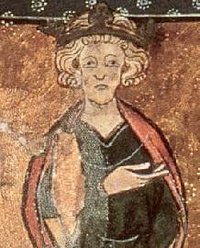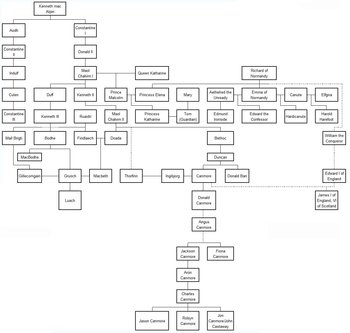Difference between revisions of "Edward the Confessor"
Phoenician (talk | contribs) |
(→Real World Background) |
||
| Line 10: | Line 10: | ||
==Real World Background== | ==Real World Background== | ||
[[Image:FamilyTree.JPG|thumb|350px|The royal family's family tree]] | [[Image:FamilyTree.JPG|thumb|350px|The royal family's family tree]] | ||
| − | Edward the Confessor was the son of Ethelred the Unready (978-1016) and Emma of Normandy, the daughter of Duke Richard of Normandy. In 1016, after his father was overthrown by Canute of Denmark (who then ruled England from 1016 to 1035), Edward fled to his mother's homeland of Normandy, and remained there until the | + | Edward the Confessor was the son of Ethelred the Unready (978-1016) and Emma of Normandy, the daughter of Duke Richard of Normandy. In 1016, after his father was overthrown by Canute of Denmark (who then ruled England from 1016 to 1035), Edward fled to his mother's homeland of Normandy, and remained there until the reign of Canute's son, Harthacanute (1040-42), when he was invited home. After Harthacanute died i 1042, Edward succeeded him to the throne. Edward was dominated by the powerful Earl Godwin of Wessex (whose daughter Edith he married) and his sons during the early part of his reign; he banished them temporarily in 1051, but they returned to favor soon afterwards. Thanks to his youth in Normandy, Edward preferred the Normans over the English, and had many Norman favorites at his court; he also promised the throne of England after his death to his cousin, Duke William of Normandy. |
Edward offered refuge at his court to the young Canmore (maybe remembering his own exile in Normandy and identifying with Canmore's plight thereby), and helped him in his war against Macbeth in 1054-57 (though the more immediate help came from Canmore's kinsman, Earl Siward of Northumbria). [[William Shakespeare]] mentions Edward in his play ''[[Macbeth (play)|Macbeth]]'', but keeps him off-stage. | Edward offered refuge at his court to the young Canmore (maybe remembering his own exile in Normandy and identifying with Canmore's plight thereby), and helped him in his war against Macbeth in 1054-57 (though the more immediate help came from Canmore's kinsman, Earl Siward of Northumbria). [[William Shakespeare]] mentions Edward in his play ''[[Macbeth (play)|Macbeth]]'', but keeps him off-stage. | ||
Revision as of 04:48, 20 January 2014
Edward the Confessor was the King of England from 1042 to 1066. He is the son of Aethelred the Unready and Emma of Normandy making him Princess Katharine's cousin.
Edward would become King in 1042 after his half-brother, the King Hardicanute, dies on his wedding day (perhaps due to poison). Immediately after becoming King, he locks up his mother, Emma, in a nunnery.[1]
In 1057, Canmore defeated Macbeth and seized the Scottish throne, with help from the English. Westminster Abbey, built by Edward the Confessor, was consecrated just a week before he died of natural causes. He was succeeded in 1066 by his brother-in-law, Harold Godwinson. [2][3]
Real World Background
Edward the Confessor was the son of Ethelred the Unready (978-1016) and Emma of Normandy, the daughter of Duke Richard of Normandy. In 1016, after his father was overthrown by Canute of Denmark (who then ruled England from 1016 to 1035), Edward fled to his mother's homeland of Normandy, and remained there until the reign of Canute's son, Harthacanute (1040-42), when he was invited home. After Harthacanute died i 1042, Edward succeeded him to the throne. Edward was dominated by the powerful Earl Godwin of Wessex (whose daughter Edith he married) and his sons during the early part of his reign; he banished them temporarily in 1051, but they returned to favor soon afterwards. Thanks to his youth in Normandy, Edward preferred the Normans over the English, and had many Norman favorites at his court; he also promised the throne of England after his death to his cousin, Duke William of Normandy.
Edward offered refuge at his court to the young Canmore (maybe remembering his own exile in Normandy and identifying with Canmore's plight thereby), and helped him in his war against Macbeth in 1054-57 (though the more immediate help came from Canmore's kinsman, Earl Siward of Northumbria). William Shakespeare mentions Edward in his play Macbeth, but keeps him off-stage.
An extremely pious king, Edward the Confessor had Westminster Abbey built; it was consecrated a few days before his death on January 5, 1066. Since he had never had children, the Witan (the royal council of England) bestowed the crown upon Harold Godwinson, Earl Godwin's oldest surviving son and Edward's brother-in-law; Duke William, angered at this act, invaded England, defeated and slew Harold at the Battle of Hastings, and became King of England as William the Conqueror. Edward was canonized in 1161.
See also
- Edward the Confessor at Wikipedia, the Free Encyclopedia

